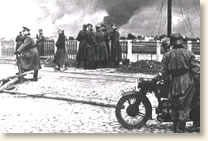|

German troops at the outskirts
of Warsaw watch the city burn
September 1939
|
On September 1, 1939 German troops swarmed across the Polish border and unleashed the first Blitzkrieg the world had seen. Hitler had been planning his attack since March - ever since German troops occupied the remainder of Czechoslovakia. The Poles suspected as much and readied their defenses. Unfortunately the Poles based their defensive strategy on the experiences of World War I. Mobility was crucial - mobility provided by cavalry troops the Poles considered the best in the world. Indeed, their horsemen were probably the world's best - but horses offered little defense against tanks.
Britain and France had sworn to defend Poland. Honoring these obligations, the
two countries sent ultimatums to Hitler demanding his withdrawal from Poland.
Hitler declined to respond. (see The Beginning
of World War II, 1939) On September 3, Prime Minister Chamberlain
went to the airwaves to announce to the British people that a state of war
existed between their country and Germany. World War II had begun.
Unfortunately Chamberlain's action was little help to the Poles. German troops advanced steadily. The final blow came on September 17 when Soviet forces under terms of a secret agreement with Germany marched into Poland from the East. Warsaw surrendered on September 27. By October 6, it was all over. Poland had ceased to exist as a country.
References: Kennedy, R.M., The Campaign In Poland, 1939 (1956); Rudnicki, K.S. The Last of the War Horses (1974).
|






